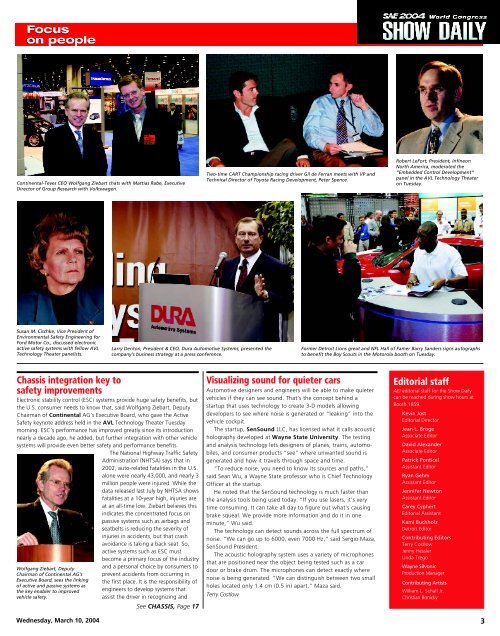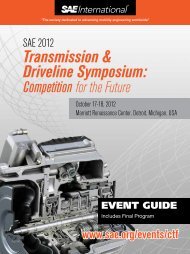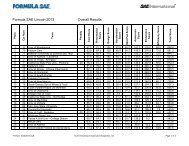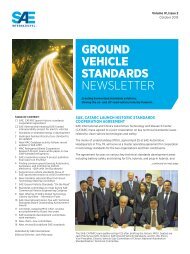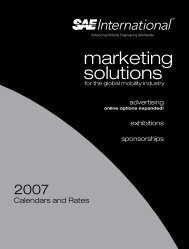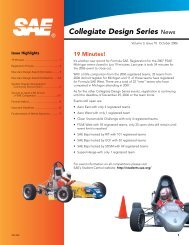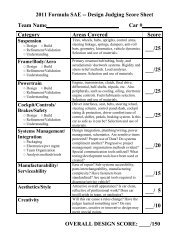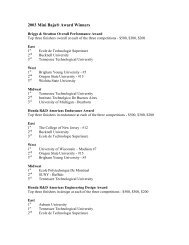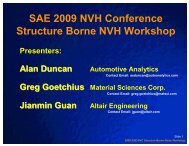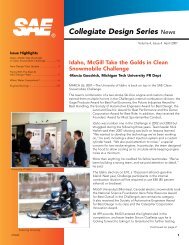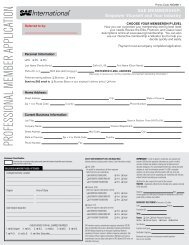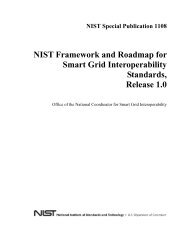Wednesday - SAE
Wednesday - SAE
Wednesday - SAE
You also want an ePaper? Increase the reach of your titles
YUMPU automatically turns print PDFs into web optimized ePapers that Google loves.
Continental-Teves CEO Wolfgang Ziebart chats with Mattias Rabe, Executive<br />
Director of Group Research with Volkswagen.<br />
Two-time CART Championship racing driver Gil de Ferran meets with VP and<br />
Technical Director of Toyota Racing Development, Peter Spence.<br />
Robert LeFort, President, Infineon<br />
North America, moderated the<br />
“Embedded Control Development”<br />
panel in the AVL Technology Theater<br />
on Tuesday.<br />
Susan M. Cischke, Vice President of<br />
Environmental Safety Engineering for<br />
Ford Motor Co., discussed electronic<br />
active safety systems with fellow AVL<br />
Technology Theater panelists.<br />
Larry Denton, President & CEO, Dura Automotive Systems, presented the<br />
company’s business strategy at a press conference.<br />
Former Detroit Lions great and NFL Hall of Famer Barry Sanders signs autographs<br />
to benefit the Boy Scouts in the Motorola booth on Tuesday.<br />
Chassis integration key to<br />
safety improvements<br />
Electronic stability control (ESC) systems provide huge safety benefits, but<br />
the U.S. consumer needs to know that, said Wolfgang Ziebart, Deputy<br />
Chairman of Continental AG’s Executive Board, who gave the Active<br />
Safety keynote address held in the AVL Technology Theater Tuesday<br />
morning. ESC’s performance has improved greatly since its introduction<br />
nearly a decade ago, he added, but further integration with other vehicle<br />
systems will provide even better safety and performance benefits.<br />
The National Highway Traffic Safety<br />
Administration (NHTSA) says that in<br />
2002, auto-related fatalities in the U.S.<br />
alone were nearly 43,000, and nearly 3<br />
million people were injured. While the<br />
data released last July by NHTSA shows<br />
fatalities at a 10-year high, injuries are<br />
at an all-time low. Ziebart believes this<br />
indicates the concentrated focus on<br />
passive systems such as airbags and<br />
seatbelts is reducing the severity of<br />
injuries in accidents, but that crash<br />
avoidance is taking a back seat. So,<br />
active systems such as ESC must<br />
become a primary focus of the industry<br />
Wolfgang Ziebart, Deputy<br />
Chairman of Continental AG’s<br />
Executive Board, sees the linking<br />
of active and passive systems as<br />
the key enabler to improved<br />
vehicle safety.<br />
and a personal choice by consumers to<br />
prevent accidents from occurring in<br />
the first place. It is the responsibility of<br />
engineers to develop systems that<br />
assist the driver in recognizing and<br />
See CHASSIS, Page 17<br />
Visualizing sound for quieter cars<br />
Automotive designers and engineers will be able to make quieter<br />
vehicles if they can see sound. That’s the concept behind a<br />
startup that uses technology to create 3-D models allowing<br />
developers to see where noise is generated or “leaking” into the<br />
vehicle cockpit.<br />
The startup, SenSound LLC, has licensed what it calls acoustic<br />
holography developed at Wayne State University. The testing<br />
and analysis technology lets designers of planes, trains, automobiles,<br />
and consumer products “see” where unwanted sound is<br />
generated and how it travels through space and time.<br />
“To reduce noise, you need to know its sources and paths,”<br />
said Sean Wu, a Wayne State professor who is Chief Technology<br />
Officer at the startup.<br />
He noted that the SenSound technology is much faster than<br />
the analysis tools being used today. “If you use lasers, it’s very<br />
time consuming. It can take all day to figure out what’s causing<br />
brake squeal. We provide more information and do it in one<br />
minute,” Wu said.<br />
The technology can detect sounds across the full spectrum of<br />
noise. “We can go up to 6000, even 7000 Hz,” said Sergio Maza,<br />
SenSound President.<br />
The acoustic holography system uses a variety of microphones<br />
that are positioned near the object being tested such as a car<br />
door or brake drum. The microphones can detect exactly where<br />
noise is being generated. “We can distinguish between two small<br />
holes located only 1.4 cm (0.5 in) apart,” Maza said.<br />
Terry Costlow<br />
Editorial staff<br />
AEI editorial staff for the Show Daily<br />
can be reached during show hours at<br />
Booth 1859.<br />
Kevin Jost<br />
Editorial Director<br />
Jean L. Broge<br />
Associate Editor<br />
David Alexander<br />
Associate Editor<br />
Patrick Ponticel<br />
Assistant Editor<br />
Ryan Gehm<br />
Assistant Editor<br />
Jennifer Newton<br />
Assistant Editor<br />
Carey Cyphert<br />
Editorial Assistant<br />
Kami Buchholz<br />
Detroit Editor<br />
Contributing Editors<br />
Terry Costlow<br />
Jenny Hessler<br />
Linda Trego<br />
Wayne Silvonic<br />
Production Manager<br />
Contributing Artists<br />
William L. Schall Jr.<br />
Christian Bonicky<br />
<strong>Wednesday</strong>, March 10, 2004<br />
3


